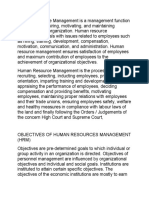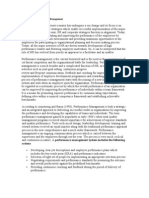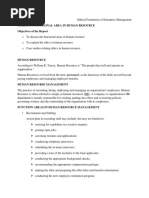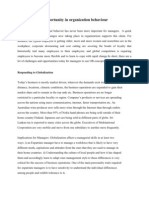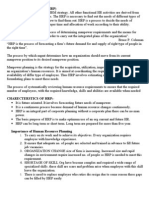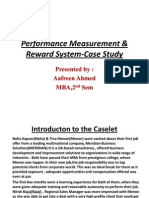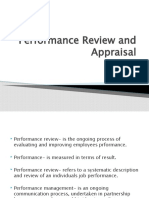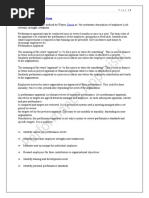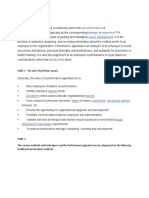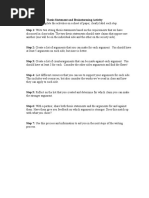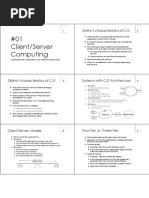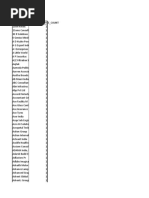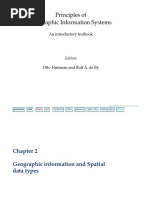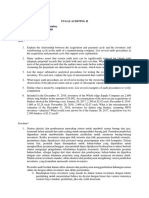Unit-7 Performance Appraisal and Reward Management
Unit-7 Performance Appraisal and Reward Management
Uploaded by
Krishna ShresthaCopyright:
Available Formats
Unit-7 Performance Appraisal and Reward Management
Unit-7 Performance Appraisal and Reward Management
Uploaded by
Krishna ShresthaOriginal Title
Copyright
Available Formats
Share this document
Did you find this document useful?
Is this content inappropriate?
Copyright:
Available Formats
Unit-7 Performance Appraisal and Reward Management
Unit-7 Performance Appraisal and Reward Management
Uploaded by
Krishna ShresthaCopyright:
Available Formats
BBS Notes - Human Resource Management | www.edunepal.
info
Unit-7 Performance Appraisal and Reward management
Performance is an individual’s action toward any kind of activities. It shows how an individual
exert his/her effort in work. So it is directly linked with productivity, efficiency and ultimately,
with the achievement of organizational objectives.
Performance appraisal is the process of evaluating an individual’s effort on job, and take
corrective measures if any deviation is found between actual and standard performance required
for a job.
According to Casio, performance appraisal is defined as “ The systematic description of job-
relevant strength and weakness of individual or group.”
Thus, performance appraisal is process of systematically evaluating performance of an individual
with a view to meet prior objective of a job.
The performance appraisal process:
a. Establish performance standard.
b. Communicate performance expectations to employees.
c. Measure actual performance.
d. Compare actual performance with standards.
e. Discuss the appraisal with the employees.
f. If necessary, initiate corrective actions.
Use of performance appraisal:
The basic uses of performance appraisals are as follows:-
a. Reward management: Performance appraisal can be used as a basis for reward allocation.
Decisions as to who gets salary increased, promotion and rewards are determined by
performance evaluation.
b. Training and development decision: Performance appraisal can be used for identifying
areas where development effort are needed. In an organization, management needs to find
out those individuals, who have specific knowledge or skill deficiencies. This helps the
management to take decision on training and development programs. So to overcome
such problems like skill deficiencies, performance appraisal can be used as a major tool.
c. Validation of selection test: Higher score in selection test means higher performer. This
can only be valid when and individual performance is evaluated and meets the
expectation of job.
d. To evaluate and individual performance: Performance of an individual play vital role in
the achievement of an organizational goal effectively and efficiently. Whether workers
are putting their full effort on work or not can only be ascertained by certain evaluation.
So performance appraisal helps in finding out the ability and performance relation and
takes corrective action if necessary.
Everest International College, Soalteemode, Kalimati, Kathmandu. 1
BBS Notes - Human Resource Management | www.edunepal.info
Methods of performance appraisal:
Following are the method used for performance appraisal.
a. Essay Method: Under this method, the appraiser/rater write an essay related to the
employee strength and weakness, previous performance and his/her potentials. Besides,
appraiser also point out the weakness and suggest the way for improvement. It is a simple
method and gives detailed information of employee. However, it is time consuming and
not easy to compare between employees .The biasness of appraiser may also exist in such
methods.
b. Checklist method: Under this method, the possible average behavior and characteristics
of an individual are listed out. The appraiser check (put tick mark) on those behaviors
which are present or showed by the employee. Once the checklist is complete, it is
usually evaluated by human resource department not the person doing the check list. The
analyst in the personal department scores the checklist as per the importance of listed
behavior and feedback to the employee and take corrective action if necessary. This
method is easy and helpful in reducing the bias of rater or appraiser. However, it is costly
and mainly focuses on employee behavior rather than performance criteria.
c. Forced choice method: The forced choice appraisal is a special type of checklist, but he
rater has to choose between two or more statement all of which may be favorable or
unfavorable. The appraiser’s job is to identify which statement is most descriptive of the
individual being evaluated. Once the evaluation is done, the HR department score the
answer based on the key (validate answers). This method is bias free. However, it is
costly and may be disliked by the appraiser because of forced selection of option.
d. Critical incident: Under this method, the appraiser write down a little story (note ) that
describe the key behavior of an individual, that make the difference between doing a job
effectively or doing it ineffectively. This method looks at the behavior and help HRM to
identify the desirable and undesirable behaviors of an individual and take corrective
action if necessary. However, it is not used for comparison.
e. Graphic rating scale: A graphic rating scale is the simplest and most popular technique
for appraising performance. It lists traits (such as quality and reliability) and a range of
performance values (from unsatisfactory to outstanding) for each trait. The supervisor
rates each subordinates by circling or checking the score that best describe his/her
performance for each trait. The assigned values for the traits are then totaled. This
method is easy to develop and comparisons among employees are possible. However, this
method is not free from bias, similarly in some cases, the evaluation criteria may not
reflects the job performance.
f. Behaviorally Anchored Rating Scale (BARS): It combines the benefits of narrative,
critical incident and quantified (graphic rating type) scales by anchoring a rating scale
with specific behavioral examples of good or poor performance.
Developing BARS typically requires five steps:
i. Generate critical incidents: person who know the job (jobholders and or
supervisors) describe specific illustration (critical incidents) of effective and
ineffective performance.
Everest International College, Soalteemode, Kalimati, Kathmandu. 2
BBS Notes - Human Resource Management | www.edunepal.info
ii. Develop performance dimension: All these critical incidents are grouped on 5 to
10 different job dimension (e.g. Technical ability, knowledge and judgment,
human relation skills etc).
iii. Reallocate incidents: Supervisor reallocates the incidents. Each relevant incident
is assigned to specific performance dimension.
iv. Scale the incident: All the incidents are scales on 7 to 9 points scales.
v. Each employee in the particular job is rated on each dimension or appropriate
scale of the BARS.
Even though it is more time consuming than others appraisal methods. It has the
advantages of preciseness, consistency and effectiveness of job evaluation.
g. Alternative ranking method: Under this method, employees are rank from best to worst
on a particular trait, choosing highest ,then lowest, until all are ranked .This method takes
considerable time for appraising and is based on subjective judgment.
h. Paired comparison method: This method rank employees by making a chart of all
possible pairs of the employees for each trait and indicating which the better employee of
the pair is. This method allows for the comparison of each employee with every other
employee. The paired comparison method is calculated by taking the total of n (n-1)/2
comparisons. This method compares each employee with another one .However it is very
difficult when larger number of employees need to be compared.
Reward / Compensation Management
• “The extent to which an individual perform his/her duty will depend on the perceived
attractiveness of the rewards offered”.
• How much and employee should be paid? , is deal with compensation management.
Reward is something of value given in return for an act. In other words, reward is what
employees received after his/her contribution in an organization. E.g. pay, benefits services etc.
In organization, reward is a vital factor for employees’ motivation. So reward system must be
managed effectively, for the effective performance of employees.
According to Gary Dessler “employee compensation /reward refer to all forms of pay or rewards
going to employees and arising from their employment”.
Types of rewards
There are two types of rewards. They are:
a. Intrinsic reward: Job related rewards are intrinsic rewards. They are the satisfaction one
gets from the job itself. These satisfactions are self-initiated rewards, such as having
pride in one’s work, having a feeling of accomplishment, or being a part of a team. The
techniques to provide intrinsic rewards are job enrichment, job rotation, flex time, shorter
work-weeks etc.
b. Extrinsic reward: Money related rewards are extrinsic reward. They include money,
promotions, other fringe benefits and the facilities provides from management etc. They
Everest International College, Soalteemode, Kalimati, Kathmandu. 3
BBS Notes - Human Resource Management | www.edunepal.info
are external to the job and come from management. Extrinsic rewards are further
classified into two categories. They are:-
i. Non-financial rewards: They do not enhance employees’ financial position .Instead,
they emphasis on making the life on job more attractive. E.g. preferred (advanced)
office furnishing, private parking spaces, business cards, one’s own secretary,
impressive title etc.
ii. Financial rewards: Financial rewards include both direct and indirect financial
payments. E.g. salary, wages, incentives, medical insurance, paid leaves, pension etc.
Financial rewards if further divided into two categories. They are:-
• Performance based reward: when the reward is allocated or pay-off for
performance, it is called performance based reward. E.g. commission, piece work
pay plans, incentives system, group bonuses etc. This type of reward system helps
to enhance the performance of employees and increases job satisfaction.
• Membership based rewards: When the reward is allocated on the basis of being a
permanent member of the organization, it is called membership based reward.
This includes, cost of living increases, profit sharing, benefits, salary increase on
the basis of seniority etc.
Qualities of effective reward/compensation management:
Following are the qualities of effective reward management:
a. Importance: Reward should be important to person receiving them. Since, reward is
significantly affected by age, marital status, knowledge level etc; of individuals it should
be designed in such a way that, it should reflect the importance to employees.
b. Visibility: Reward should be visible. Employees should know and realize what they get
against their effort. This help in comparison between others as well as in enhancing the
employees’ satisfaction level.
c. Equitable distribution: Reward must be fairly distributed in comparison to the referent
group (such as in comparison to other individuals in similar job, in comparison to similar
job and in other organization and in comparison to the effort used and outcome received).
d. Flexibility: An effective reward is one that has the flexibility to change with the changes
in performance. It should be flexible in terms of the amount paid and the people to whom
it is given in an organization.
e. Low cost: Reward should be cost effective. Cost-benefit analysis should be considered
while designing the rewards.
Determinants of Compensation:
Followings are the determinants of compensation:
a. Legal consideration: Government rules and regulation provides many guidelines to
compensate employees. Companies have to comply with these rules and regulation while
determining the pay level for employees.
Everest International College, Soalteemode, Kalimati, Kathmandu. 4
BBS Notes - Human Resource Management | www.edunepal.info
b. Market rates: Competitive pay system is only possible when organization match its pay
with the prevailing market rate. So organization should thoroughly analyze the labour
rates and its trends to determine the pay system.
c. Union Pressure: Labour union represents the voice of employees. It plays major role in
determining the salary and wages along with other non-financial rewards. Thus,
organization should constructively discuss with unions for determining effective reward
policy.
d. Job evaluation: Effective job evaluation leads to effective reward policy. So organization
should analyze cost and benefits relation, skills required and organizational standard on
determining rewards.
Methods of establishing (setting) employee compensation:
Compensation against effort determines the motivation level of employees. So while setting a
pay rate or compensation, management should meticulously analyze different variables or
determinants affecting compensation.
Following are the methods to set pay rates:
a. The salary survey: It is a method of collecting factual information on pay practices within
specific communities and among firms in their industry for comparison purpose. It can be
formal (i.e. structural questionnaire is used to collect the data) or informal (i.e. telephone
or internet queries.)
b. Job evaluation: It is a systematic comparison done in order to determine the worth of one
job relative to another. The fundamental compensable elements of a job, such as skills,
efforts, working conditions and responsibility are compared to one another and set pay
for each job. Different methods like, ranking method, classification method, factor
comparison method and point method can be used to evaluate the job.
c. Wage curve fitting: When management arrives at point totals from job evaluation and
obtains survey data on what comparable organizations are paying for similar job, then
wage curve can be fitted to the data. Wage curve shows the relationship between the
value of the job and the average wage paid for this job.(Fig from book)
d. Wage structure: Finally, the jobs that are similar in terms of classes, grades or points are
grouped together and are plotted in a graph to develop an organization’s wage structure.
The wage structure shows the pay ranges in each grade at stated time period. (Fig from
book)
Current trends in Compensation:
Current trends in compensation are as follows:
a. Competency based pay: Competencies are the demonstrable characteristics of a person,
including knowledge, skills and behavior that enable performance. So, when the company
pays for employee’s range, depth and types of skills and knowledge, rather than for the
job title s/he holds, then it is called competency based pay. Now a days, companies are
Everest International College, Soalteemode, Kalimati, Kathmandu. 5
BBS Notes - Human Resource Management | www.edunepal.info
focusing on determining the compensation as per the competency due to the following
reasons:
i. Pay for skills or knowledge enhances motivation, which uplifts performance.
ii. Paying for skills, knowledge and competencies is more strategic.
iii. Measurable skills, knowledge and competencies are the heart of any company’s
performance management process.
b. Broad-banding: It means collapsing or grouping salary, grades and ranges into just a few
wild level or bands, each of which contains a relatively wide range of jobs and salary
level. Broad-banding supports the hierarchical arrangement of management systems as
well as strategic performance improvement initiatives. So it is becoming popular in
today’s organization.
c. Comparable worth: Comparable worth refers to the requirement to pay men and women
equal wages for jobs that are the comparable (rather than strictly equal) value to the
employer. Under this several job factors like, skills, effort and responsibility and
authority etc are assigned with points and total points are compared between different
jobs to provide the similar compensation for similar points. This is used to determine
determine the compensation for dissimilar job such as nurse to truck mechanic or
technician etc.
Incentive Plans:
Incentive is a additional pay for higher performer to enhance motivation level. In other
words, it is monetary benefits paid to employees for outstanding performance .E.g. gain
sharing, commission, bonus, piece work plans etc.
Types of incentive plans:
a. Individual incentive plans: It is concerned with individual performance on work sites.
Under this, following types of rewards are provided to an individual.
i. Piece rate (piece work) pay: Usually, it is provided to manufacturing worker.
Under this, standard output is determined first and the workers are paid higher
rate for the output produced above that standard output.
ii. Commission plan: Usually, it is provided to the sales person or the mediator who
helps in enhancing the organizational effectiveness. It may be direct (i.e. pay
commission per unit sold) or indirect (i.e. pay on overall sales by adding with the
salary paid)
iii. Bonus plan: It is a onetime lump-sum amount paid to the management or
professional employee for their outstanding performance. Different types of bonus
scheme are provided by the organization such as, end of year bonus (i.e. paid at
the end of year), spot bonus (i.e. paid on spot once the target is achieved by an
individual) etc.
b. Group Incentive plan: It is concerned with providing the reward for the group
performance. They are:
i. Piece rate
ii. Commission Plan
Everest International College, Soalteemode, Kalimati, Kathmandu. 6
BBS Notes - Human Resource Management | www.edunepal.info
iii. Bonus Plan.
c. Organizational incentive plan: It is concerned with the improvement of overall
organizational performance. Under this, the additional extrinsic reward is provided to all
of the employees to appreciate their efforts. Following are the types of organizational
incentive plan:
i. Productivity gain sharing: It is related to productivity improvement. The cost that
has been saved on production or operation because of outstanding efficiency
improvement is distributed as bonus to the employees.
ii. Profit sharing: Under this, certain percentage of profit is distributed as bonus to all
the employees as bonus for their effective performance.
iii. Employee share ownership: Under this employees are given opportunity to
participate in ownership by providing shares either as a gift or below the market
price. This type of incentive helps to build belongingness towards organization
and boost up motivation level.
Union influence on compensation program:
Union is a representative body who vocal the issues and grievances of employees to the
management. It collectively promotes and protects the mutual interest of employees. So union
play vital role in determining the compensation program in an organization. The union influences
compensation programs in the following ways:
a. Pressure to increase salary following some changes in the consumer price index (CPI):
CPI give idea about the increasing or decreasing of product. So, when CPI is increased
union may give pressure to management to increase the salary or other benefits to meet
the cost of living.
b. Securing Jobs: Unions always advocate on securing the jobs of the employees. They
vocal on employees’ improvement through training and development program instead of
little increment in incentive.
c. Work to develop trust between union- management: Union work closely with
management. They take part in major HR related decisions such as on compensation,
safety, training and development etc., which not only enhance the relation between them
but also foster participate management in an organization.
Everest International College, Soalteemode, Kalimati, Kathmandu. 7
You might also like
- Pclaw 10: User GuideDocument364 pagesPclaw 10: User GuideHaroon RashidNo ratings yet
- Objectives of Human Resources ManagementDocument32 pagesObjectives of Human Resources ManagementGhanshyam KashyapNo ratings yet
- Communication Is One of The Basic Functions of Management in Any Organization and Its Importance Can Hardly Be OveremphasizedDocument15 pagesCommunication Is One of The Basic Functions of Management in Any Organization and Its Importance Can Hardly Be Overemphasizedtejas203735075% (4)
- HR Job Description &job SpecificationDocument4 pagesHR Job Description &job Specificationemmanuel Johny100% (5)
- Chapter 3: Needs Assessment Chapter 3: Needs AssessmentDocument41 pagesChapter 3: Needs Assessment Chapter 3: Needs Assessmentjoshua ursalNo ratings yet
- Changing Landscape of WorkDocument8 pagesChanging Landscape of WorkA K Azad SumanNo ratings yet
- Socializing, Orienting, and Developing EmployeesDocument34 pagesSocializing, Orienting, and Developing EmployeesAshish KumarNo ratings yet
- Human Resources Is Made Up of How Many Areas of KnowledgeDocument10 pagesHuman Resources Is Made Up of How Many Areas of KnowledgeTolu Olusakin0% (1)
- Performance Appraisal Nature of Performance Appraisal:: UNIT-4Document33 pagesPerformance Appraisal Nature of Performance Appraisal:: UNIT-4Sara taskeena100% (1)
- Narrative Review SampleDocument2 pagesNarrative Review SampleMohammad AmanNo ratings yet
- Definition of Performance ManagementDocument31 pagesDefinition of Performance ManagementPrabu PappuNo ratings yet
- Job Analysis Is Conducted To Determine TheDocument14 pagesJob Analysis Is Conducted To Determine TheMarkmarilynNo ratings yet
- Functions of Human Resource DepartmentDocument2 pagesFunctions of Human Resource DepartmentRheneir Mora100% (1)
- Improving Performance: HR Practices Around The GlobeDocument7 pagesImproving Performance: HR Practices Around The GlobedoraemonNo ratings yet
- Performance Management Overview:: Module in Human Resource Development and ManagementDocument8 pagesPerformance Management Overview:: Module in Human Resource Development and ManagementRevenlie GalapinNo ratings yet
- Presentation On: Performance Management SystemDocument15 pagesPresentation On: Performance Management SystemRadhika Reddy100% (2)
- Training and Developing EmployeesDocument20 pagesTraining and Developing Employeessakshi_tyagi_150% (2)
- Chapter 22 - Methods of Motivation at WorkDocument5 pagesChapter 22 - Methods of Motivation at WorkDiya Sandeep100% (1)
- Case Study 2Document2 pagesCase Study 2Juvilyn Ebao100% (1)
- Performance AppraisalDocument14 pagesPerformance Appraisalnavsangeet_21No ratings yet
- Unilever 1Document34 pagesUnilever 1Đặng HữuNo ratings yet
- Human Resource Management-2 MBADocument34 pagesHuman Resource Management-2 MBAjio team100% (2)
- Human Resource ManagementDocument20 pagesHuman Resource ManagementDorah LetsholoNo ratings yet
- Methods of Wage PaymentsDocument7 pagesMethods of Wage PaymentsSaurabh M. SaleNo ratings yet
- DepartmentalizationDocument4 pagesDepartmentalizationFaziela TamizziNo ratings yet
- Chapter 3: Internal AlignmentDocument3 pagesChapter 3: Internal AlignmentRaphael Renan OclaritNo ratings yet
- Purpose of The Performance ManagementDocument5 pagesPurpose of The Performance ManagementPeter ChitembedyaNo ratings yet
- Ethics Report - Functional AreaDocument4 pagesEthics Report - Functional AreaDominique Bernice VillanuevaNo ratings yet
- Performance AppraisalDocument3 pagesPerformance AppraisalMohd Fariq0% (1)
- Importance of A Job TitleDocument2 pagesImportance of A Job TitleLORAINENo ratings yet
- COMPENSATION 1 - Pay Plans - Basic IssuesDocument48 pagesCOMPENSATION 1 - Pay Plans - Basic IssuesArefin Wisea AblagNo ratings yet
- Training and Development Case StudyDocument3 pagesTraining and Development Case StudyDamil Alam PrakashNo ratings yet
- Meaning of StaffingDocument3 pagesMeaning of StaffingBernadette LlanetaNo ratings yet
- Effect of Motivational Factors On Job Satisfaction of Rank and File Employee in Selected Fast Food Restaurant in Lucena CityDocument26 pagesEffect of Motivational Factors On Job Satisfaction of Rank and File Employee in Selected Fast Food Restaurant in Lucena Citydymark de torres100% (2)
- Chapter 8 Training and Developing Employees. RevisionDocument16 pagesChapter 8 Training and Developing Employees. RevisionFatma AbdelnaemNo ratings yet
- Career Planning and DevelopmentDocument11 pagesCareer Planning and DevelopmentMuthu KumaranNo ratings yet
- Performance ManagementDocument14 pagesPerformance ManagementThanga RajaNo ratings yet
- Q1 Functional Organization Has Been Divided To Put The Specialists in The Top Position Throughout The EnterpriseDocument7 pagesQ1 Functional Organization Has Been Divided To Put The Specialists in The Top Position Throughout The EnterpriseSneha ShadiNo ratings yet
- 1.6challenges and Opportunity For Organization Behaviour 1Document13 pages1.6challenges and Opportunity For Organization Behaviour 1Balakrishna Nalawade N0% (1)
- Human Resource Planning (HRP) HRP Is TheDocument5 pagesHuman Resource Planning (HRP) HRP Is Themehtamehul2904No ratings yet
- PMSDocument27 pagesPMSMeha SinghNo ratings yet
- Performance Measurement & Reward System-Case StudyDocument7 pagesPerformance Measurement & Reward System-Case StudyAafreen AhmedNo ratings yet
- Influence On Employee BehaviourDocument24 pagesInfluence On Employee Behaviourbeta rizqi100% (1)
- Reaction Paper of Job Analysis and Talent Management CH 4Document1 pageReaction Paper of Job Analysis and Talent Management CH 4Snarf Iban100% (1)
- CHAPTER 6 Performance Review and AppraisalDocument5 pagesCHAPTER 6 Performance Review and AppraisalPatricia Louise Sy GuardianaNo ratings yet
- Pay Equity Internal and External Conside PDFDocument9 pagesPay Equity Internal and External Conside PDFOnline AccessNo ratings yet
- Job Analysis, Job Design and Quality of Work LifeDocument14 pagesJob Analysis, Job Design and Quality of Work Lifes1103294475% (8)
- Fundamentals of Manpower Planning (UNIT1)Document76 pagesFundamentals of Manpower Planning (UNIT1)Jobin JohnNo ratings yet
- Case Studies On Human Resource Planning Relevant IssuesDocument33 pagesCase Studies On Human Resource Planning Relevant IssuesMehenaj Sultana BithyNo ratings yet
- Description: An Operation Process Chart Provides The Chronological Sequence of All OperationsDocument7 pagesDescription: An Operation Process Chart Provides The Chronological Sequence of All Operationsfrances beeNo ratings yet
- Using Job Analysis and Competency Modeling As The Foundation For The HR SystemDocument17 pagesUsing Job Analysis and Competency Modeling As The Foundation For The HR SystemMariele Manlagnit ColumnaNo ratings yet
- Recruitment Process Outsourcing A Complete Guide - 2020 EditionFrom EverandRecruitment Process Outsourcing A Complete Guide - 2020 EditionNo ratings yet
- HRM Research - Performance AppraisalDocument7 pagesHRM Research - Performance AppraisalMichael John SumileNo ratings yet
- Unit - Iii Performance AppraisalDocument9 pagesUnit - Iii Performance AppraisalSai PrabhasNo ratings yet
- Unit - Iii Performance AppraisalDocument9 pagesUnit - Iii Performance AppraisalSai PrabhasNo ratings yet
- Performance Appraisal NotesDocument9 pagesPerformance Appraisal NotesmohdsabirNo ratings yet
- Performance Appraisal MethodsDocument5 pagesPerformance Appraisal MethodsShyam ji DubeyNo ratings yet
- Presentation of HRMDocument40 pagesPresentation of HRMsonipmgr113No ratings yet
- Human Resource ManagementDocument32 pagesHuman Resource ManagementKhadarNo ratings yet
- Job Performance Employee Evaluated Manager Supervisor Career DevelopmentDocument6 pagesJob Performance Employee Evaluated Manager Supervisor Career DevelopmentKunal RajputNo ratings yet
- HRM Unit 5Document10 pagesHRM Unit 5fahmee0004No ratings yet
- Unit 8 Employee Discipline: Type of Disciplinary ProblemsDocument2 pagesUnit 8 Employee Discipline: Type of Disciplinary ProblemsKrishna ShresthaNo ratings yet
- Unit 6 Motivation PDFDocument8 pagesUnit 6 Motivation PDFKrishna ShresthaNo ratings yet
- Unit 5 Training and Development: LearningDocument10 pagesUnit 5 Training and Development: LearningKrishna ShresthaNo ratings yet
- Unit 3 Job Design and Job AnalysisDocument8 pagesUnit 3 Job Design and Job AnalysisKrishna ShresthaNo ratings yet
- Unit 1 Concept of Human Resources Management: BBS Notes - Human Resource Management - WWW - Edunepal.infoDocument6 pagesUnit 1 Concept of Human Resources Management: BBS Notes - Human Resource Management - WWW - Edunepal.infoKrishna ShresthaNo ratings yet
- Topic 1 - NOUNSDocument7 pagesTopic 1 - NOUNSLala Amelia PutriNo ratings yet
- Self-Damping of Conductors Aac, Aaac and Acsr With Respect of HW ParameterDocument9 pagesSelf-Damping of Conductors Aac, Aaac and Acsr With Respect of HW ParameterElías FurthNo ratings yet
- Argumentative Essay BrainstormingDocument1 pageArgumentative Essay Brainstormingapi-293392875No ratings yet
- Learning Activity Sheet SampleDocument6 pagesLearning Activity Sheet SampleMitchelle Dawn PayeNo ratings yet
- 01 - Client Server ComputingDocument3 pages01 - Client Server ComputingnithyaNo ratings yet
- 0450 - R6 Analyzer SheltersDocument32 pages0450 - R6 Analyzer Sheltersrobert benavidesNo ratings yet
- Priyank - MA AccountDocument435 pagesPriyank - MA Accountshraddha singhNo ratings yet
- PresentationDocument16 pagesPresentationதுரைராஜ் இலட்சுமணன்No ratings yet
- A Systematic Review of Evidence For PsychologicalDocument8 pagesA Systematic Review of Evidence For PsychologicalLautaro FerreiraNo ratings yet
- Reading 2: Module 4: Methods of Teaching English To Young Learners (Primary Level)Document4 pagesReading 2: Module 4: Methods of Teaching English To Young Learners (Primary Level)Nguyễn Ngọc NhungNo ratings yet
- Grade 9: The Second SemesterDocument10 pagesGrade 9: The Second SemesterTấn Tài VõNo ratings yet
- Using FreeGlut With Code - Blocks - CodeBlocksDocument7 pagesUsing FreeGlut With Code - Blocks - CodeBlocksCarlosGuerrero1973No ratings yet
- 190-ECDIS JRC JAN-7201S-9201S Instruct Manual Basic 27-7-2020Document286 pages190-ECDIS JRC JAN-7201S-9201S Instruct Manual Basic 27-7-2020Ryan PushNo ratings yet
- Peningkatan Kinerja Aparatur Sipil NegaraDocument14 pagesPeningkatan Kinerja Aparatur Sipil NegaraSarwo edi100% (1)
- Dsp9200 SeriesDocument70 pagesDsp9200 Seriesvanadium0No ratings yet
- Refresher 01Document4 pagesRefresher 01breimanangNo ratings yet
- Devops With Awscourse Content LatestDocument10 pagesDevops With Awscourse Content LatestAshish SinghNo ratings yet
- Updated Hse Red Amber GreenDocument2 pagesUpdated Hse Red Amber GreenAndrea BiondaNo ratings yet
- 27-Principlesgis UnlockedDocument74 pages27-Principlesgis UnlockedCHRISTIAN LANDAVAZONo ratings yet
- 2ND-summative TOSDocument7 pages2ND-summative TOSzyan reyesNo ratings yet
- Mseke IrsDocument13 pagesMseke IrsAggrey KigodiNo ratings yet
- Regression AnalysisDocument8 pagesRegression AnalysisSlamat Parulian SimamoraNo ratings yet
- Chris Miles - The Marketing of Service-Dominant Logic - A Rhetorical Approach-Palgrave Macmillan (2023)Document263 pagesChris Miles - The Marketing of Service-Dominant Logic - A Rhetorical Approach-Palgrave Macmillan (2023)Sumith ChandrakumaraNo ratings yet
- Low-Voltage Low-Power Adders: Unit-IvDocument24 pagesLow-Voltage Low-Power Adders: Unit-Ivrakesh100% (5)
- Tanzanya Tiyatro EğitimiDocument30 pagesTanzanya Tiyatro EğitimiZüleyha ÇubukNo ratings yet
- New Chinese Style PowerPoint TemplatesDocument24 pagesNew Chinese Style PowerPoint TemplatesGeurimjaNo ratings yet
- Globetech Computer Ms Access Note 2020Document5 pagesGlobetech Computer Ms Access Note 2020partmore enterprisesNo ratings yet
- Sap Abap Error CodeDocument12 pagesSap Abap Error CodevmuthukumaarNo ratings yet
- Tugas Individu Audit IIDocument4 pagesTugas Individu Audit IIChelsea KambeyNo ratings yet

